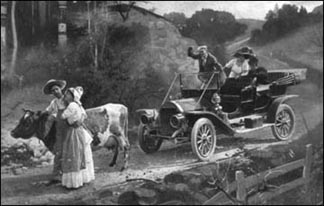
Historical
Society
2000 Articles
Museum Cars
7.19.00
Paynesville Firsts
7.12.00
Dolls
7.5.00
Schools
6.28.00
Bison
6.14.00

|
Notes from the Paynesville Historical Society. . .
Dr. Pilon brought first car to Paynesville
The auto came into Paynesville on a flat car as it had to be shipped in pieces. About 50 people were on hand when it arrived and they began to bet among themselves whether the car would run after being put together.
The doctor and his friends rolled up their shirt sleeves and began to assemble the car. Dr. Pilon took on all bets, which he won when the car started and whirred away.
An early resident told of meeting the doctor on a country road and many had their horses run away in sheer fright of the strange machine.
One day Dr. Pilon hit a rut in the road and he was ejected from the car into a newly plowed field. A farmer was coming along the road and saw him lying there, but before he could help Dr. Pilon, the doctor jumped up, brushed himself off, and said, "For God's sake, don't tell anybody." But the story got around that the good doctor put the pedal to the metal, driving nearly 30 miles an hour and that it landed him in a field.
It became an understood custom between horse driver and car driver, that when they met on a narrow road, the car would stop a distance ahead so that the horse driver would have a chance to hold his team from running off as the automobile rattled past.
When registration became mandatory in 1903, Dr. Pilon paid $2 for registration of his automobile. He painted a large number one on his license plate.
An automobile's front lights lit up when the car was running. The faster the car went, the brighter the lights. There was no light inside the car. Sidelights and taillights burned kerosene with a wick. No water pumps or oil pumps were used. The connecting rod had a little cup which as it went around, splashed oil all over the motor. On the steering wheel were two levers, one was for gas and the other for spark.
The car had to be cranked to start it. When you cranked it you didn't dare grip the handle with your thumb. It would be broken. With the thumb at the side, you cranked with the right hand, pulled the choke with your left, all the time listening to it cough. When it started, you ran around and gave it more spark.
Many, many broken thumbs and arms were received from trying to crank the motor car. The crank could whip back on you with a vengeance. Jan Peterson says many people were disabled for life.Their arms would be badly broken and many times not set correctly. Then the arm would heal wrong or crooked.
Traveling by automobile was no picnic. Roads were lousy. Often dusty or muddy and with deep ruts. Tires on the car were poor.
On a typical trip, men dressed in raincoats. They wore special headgear and goggles.Women wore "dusters" which were neck-to-toe coats that protected their clothes.
There would be mud up to the hub caps. Half the time you were either pushing the car out of the mud or trying to keep the blankety-blank car running. In the meantime, smart alecks were yelling, "Get a horse."
If you were stuck out in the country, often times fuel was at outrageous prices, such as 12 to 25 cents a gallon.
Pneumatic tires punctured easily. Travelers needed to have two spare tires and tubes with them.
If you were traveling with a party of vehicles, drivers had to be very ingenious about marking a path for the rest of the entourage to follow, because the mud would cover their tracks. They might use white beans, but then the road would be full of chickens eating the beans. Later cars followed the feathers from the hit and run chickens. The last driver followed the broken automobile springs from running over the corpses of the poor hit and run chickens.
Come to the Paynesville Historical Museum and see the 1925 Ford Coupe, donated by Marcia McCarney.
If anyone has any wheelchairs or walkers that they could donate, please call the historical society at 243-7547 or Bertha Zniewski at 243-4433.
|
 The first automobile in Paynesville was owned by Dr. P.C. Pilon. It was sold to him by Aaron Nehring in 1902.
The first automobile in Paynesville was owned by Dr. P.C. Pilon. It was sold to him by Aaron Nehring in 1902.